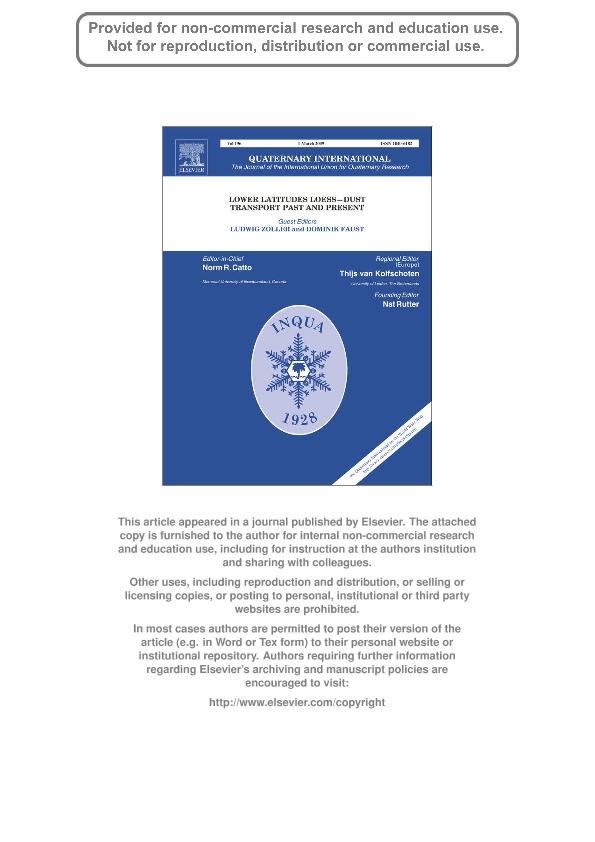Mostrar el registro sencillo del ítem
dc.contributor.author
Zech, W.
dc.contributor.author
Zech, M.
dc.contributor.author
Zech, R.
dc.contributor.author
Peinemann, Norman

dc.contributor.author
Morrás, Héctor José María

dc.contributor.author
Moretti, Lucas Martin

dc.contributor.author
Olge, N.
dc.contributor.author
Kalim, R. M.
dc.contributor.author
Fuchs, M.
dc.contributor.author
Schad, P.
dc.contributor.author
Glaser, B.
dc.date.available
2019-04-08T18:50:38Z
dc.date.issued
2009-03
dc.identifier.citation
Zech, W.; Zech, M.; Zech, R.; Peinemann, Norman; Morrás, Héctor José María; et al.; Late Quaternary palaeosol records from subtropical (38°S) to tropical (16°S) South America and palaeoclimatic implications; Pergamon-Elsevier Science Ltd; Quaternary International; 196; 1-2; 3-2009; 107-120
dc.identifier.issn
1040-6182
dc.identifier.uri
http://hdl.handle.net/11336/73450
dc.description.abstract
Loess and palaeosols in the subtropical lowlands of South America (∼23-38°S) have a large potential to serve as archives of Late Quaternary environmental and climate changes. At present, mean annual precipitation generally decreases from N to S and from E to W, though with a complex seasonal pattern with austral summer rainfall related to the monsoonal circulation and with austral winter rainfall related to the SE-trades. In this paper, we present results of multiproxy geochemical analyses from three representative eolian/alluvial soil profiles along a S-N transect aiming at the reconstruction of past climate changes: (i) profile "Chasico" at the southern border of the subtropics (38°S), (ii) "D4" in Misiones at the northern border of the subtropics (27°S), and, for comparison, (iii) "Laguna Sucuara" in the savannas of the Bolivian lowlands (16°S). Our results show that before ∼16 ka BP, conditions were likely very cold and dry. Except for in "D4", loess or soils are not preserved due to rather scarce vegetation cover and resultant deflation. In "Chasico", accumulation of sands (directly overlying the Tertiary) starts only during the Late Glacial, indicating increasing temperatures and increased monsoonal precipitation (coinciding with the "Tauca" wet phase on the Altiplano). In "D4", a palaeosol is preserved below the Late Glacial sediments and the deflation hiatus. This palaeosol is dated to ∼40 ka BP and documents an earlier, but less intensive (southward reaching) phase of monsoonal precipitation ("Inca Huasi" on the Altiplano). Whereas the seasonality during the Late Glacial seems to have been very pronounced, conditions for organic matter production and preservation became much more favourable at "Chasico" and "D4" during the Early Holocene. We suggest that extra-tropical winter precipitation played a more important role than before and than today. Between ∼7.5 and 3 ka BP, the expansion of C4 plants along the S-N transect suggests increasing aridity, probably due to a weakening of the extra-tropical circulation in combination with a relatively weak monsoonal circulation. Only after ∼3 ka BP climate became more humid again due to the re-strengthening of the monsoon.
dc.format
application/pdf
dc.language.iso
eng
dc.publisher
Pergamon-Elsevier Science Ltd

dc.rights
info:eu-repo/semantics/openAccess
dc.rights.uri
https://creativecommons.org/licenses/by-nc-sa/2.5/ar/
dc.subject
Paleoclimatic Data
dc.subject
Soil Datation
dc.subject.classification
Meteorología y Ciencias Atmosféricas

dc.subject.classification
Ciencias de la Tierra y relacionadas con el Medio Ambiente

dc.subject.classification
CIENCIAS NATURALES Y EXACTAS

dc.title
Late Quaternary palaeosol records from subtropical (38°S) to tropical (16°S) South America and palaeoclimatic implications
dc.type
info:eu-repo/semantics/article
dc.type
info:ar-repo/semantics/artículo
dc.type
info:eu-repo/semantics/publishedVersion
dc.date.updated
2019-03-26T20:36:15Z
dc.journal.volume
196
dc.journal.number
1-2
dc.journal.pagination
107-120
dc.journal.pais
Países Bajos

dc.journal.ciudad
Amsterdam
dc.description.fil
Fil: Zech, W.. University of Bayreuth; Alemania
dc.description.fil
Fil: Zech, M.. University of Bayreuth; Alemania
dc.description.fil
Fil: Zech, R.. University of Bern; Suiza
dc.description.fil
Fil: Peinemann, Norman. Universidad Nacional del Sur; Argentina
dc.description.fil
Fil: Morrás, Héctor José María. Instituto Nacional de Tecnologıa Agropecuaria; Argentina
dc.description.fil
Fil: Moretti, Lucas Martin. Consejo Nacional de Investigaciones Científicas y Técnicas; Argentina. Instituto Nacional de Tecnologıa Agropecuaria; Argentina
dc.description.fil
Fil: Olge, N.. The Queens University of Belfast; Irlanda
dc.description.fil
Fil: Kalim, R. M.. The Queens University of Belfast; Irlanda
dc.description.fil
Fil: Fuchs, M.. University of Bayreuth; Alemania
dc.description.fil
Fil: Schad, P.. Universitat Technical Zu Munich; Alemania
dc.description.fil
Fil: Glaser, B.. University of Bayreuth; Alemania
dc.journal.title
Quaternary International

dc.relation.alternativeid
info:eu-repo/semantics/altIdentifier/doi/http://dx.doi.org/10.1016/j.quaint.2008.01.005
dc.relation.alternativeid
info:eu-repo/semantics/altIdentifier/url/https://www.sciencedirect.com/science/article/pii/S1040618208000050
Archivos asociados
